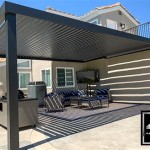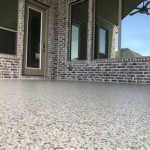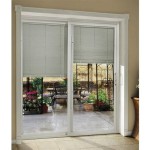Replacement Patio Door Blind Slats: A Comprehensive Guide
Patio doors, designed to seamlessly connect indoor and outdoor living spaces, often incorporate blinds for privacy and light control. Over time, however, these blinds can suffer damage. Broken, bent, or discolored slats detract from the aesthetic appeal of the door and compromise its functionality. Replacing individual slats offers a cost-effective and environmentally conscious alternative to replacing the entire blind system. This article provides a comprehensive guide to understanding the process of replacing patio door blind slats, encompassing the types of slats available, the tools and techniques involved, and factors to consider for a successful replacement.
Understanding Patio Door Blind Types and Slat Compatibility
Before embarking on a slat replacement project, it is crucial to identify the type of blinds installed on the patio door. Common types include vertical blinds, horizontal blinds (also known as Venetian blinds), and pleated shades. Vertical blinds, characterized by long, vertical slats suspended from a track, are often found on patio doors due to their ability to cover large expanses and their ease of operation. Horizontal blinds feature slats that run horizontally and can be tilted to control light and privacy. Pleated shades, while not technically blinds, are often used on patio doors and consist of a pleated fabric material that raises and lowers.
The type of blind dictates the type of slat required. Vertical blind slats are typically made of PVC, fabric, or aluminum. Horizontal blind slats are commonly constructed from aluminum, wood, or faux wood. Pleated shades do not have individual slats, but damaged sections of the pleated fabric can sometimes be replaced or repaired. Once the blind type is identified, the material of the existing slats should be determined to ensure compatibility with the replacement slats.
Furthermore, slat dimensions are critical for a proper fit. Measure the width and thickness of the existing slats accurately, paying close attention to any curvature or specific design features. Slat width is particularly important for horizontal blinds, as variations can affect the overall appearance and functionality of the blind. For vertical blinds, measure the length of the slat from the top carrier to the bottom weight pocket. Matching the slat size precisely ensures that the replacement slats integrate seamlessly with the existing blind system.
The method of attachment also differs depending on the blind type. Vertical blind slats typically have a pre-punched hole or a clip at the top that attaches to the carrier in the headrail. Horizontal blind slats are connected by strings or ladders running through evenly spaced holes. Understanding the attachment mechanism is essential for selecting replacement slats with the appropriate configuration.
Tools and Materials Required for Slat Replacement
Successful slat replacement requires a few essential tools and materials. A flathead screwdriver is useful for gently prying open the slat holders or clips on vertical blinds. A measuring tape is necessary for accurately measuring the dimensions of the existing slats. A utility knife or sharp scissors may be needed to trim replacement slats to the correct length, particularly for vertical blinds. A pair of pliers can assist with manipulating small parts and securing slat holders.
In addition to tools, the following materials are crucial: replacement slats of the correct type, size, and material; replacement slat holders or clips (if needed); and a ladder or step stool to reach high windows. For horizontal blinds, replacement string or ladder cord may be required if the existing cord is damaged or frayed during the slat replacement process. Protective eyewear is recommended to prevent dust or debris from entering the eyes during the repair.
When selecting replacement slats, consider purchasing a few extra to account for potential errors during installation or future damage. It is also advisable to purchase slats from a reputable supplier that offers a wide selection of sizes, materials, and colors. This ensures that the replacement slats closely match the existing blinds and meet quality standards.
Step-by-Step Guide to Replacing Patio Door Blind Slats
The procedure for replacing patio door blind slats varies depending on the type of blinds. For vertical blinds, the first step is to carefully detach the damaged slat from the carrier at the top. This usually involves gently prying open the slat holder or clip using a flathead screwdriver. Once the damaged slat is removed, measure the length of the slat and trim the replacement slat to the same length using a utility knife or sharp scissors. Attach the replacement slat to the carrier, ensuring that it is securely fastened. Repeat this process for any other damaged slats.
For horizontal blinds, the process is more involved. First, tilt the blinds to the open position. Identify the ladder cords or strings that support the slats. Carefully remove the bottom rail cap to access the cord ends. Untie the knots securing the cords to the bottom rail. Gently slide the damaged slats out of the ladder cords. Insert the replacement slats into the ladder cords, ensuring that they are aligned correctly. Retie the cord ends to the bottom rail, securing them with tight knots. Replace the bottom rail cap. Repeat this process for any other damaged slats.
When replacing slats on horizontal blinds, it is important to maintain the correct tension on the lift cords. If the cords are too loose, the blinds will not raise and lower properly. If the cords are too tight, the blinds may be difficult to operate and could potentially damage the lifting mechanism. After replacing the slats, test the blinds to ensure that they raise and lower smoothly and that the slats are evenly spaced.
For pleated shades, replacing damaged sections is often a more complex process that may require professional assistance. If the damage is minor, it may be possible to repair the shade using fabric glue or by stitching the torn fabric together. However, if the damage is extensive, it may be necessary to replace the entire shade.
Factors to Consider for a Successful Slat Replacement
The success of a slat replacement project hinges on several factors. Accurately identifying the blind type and slat material is paramount. Matching the slat dimensions precisely is crucial for a seamless integration and proper functionality. Using the appropriate tools and techniques minimizes the risk of further damage to the blinds. Purchasing high-quality replacement slats ensures durability and longevity.
Proper preparation is essential. Before starting the project, gather all the necessary tools and materials. Clear the area around the patio door to provide ample workspace. Protect the floor with a drop cloth to prevent spills or scratches. Take your time and work carefully to avoid mistakes. If unsure about any step of the process, consult online resources or seek professional assistance.
Maintaining the blinds after slat replacement is also important. Regularly dust the slats with a soft cloth or vacuum cleaner to prevent buildup. Avoid using harsh chemicals or abrasive cleaners, as these can damage the slat finish. Periodically inspect the cords and ladders for signs of wear and tear. Replace damaged cords promptly to prevent further problems. By following these maintenance tips, the blinds can remain in good condition for many years to come.
Troubleshooting Common Slat Replacement Issues
Despite careful planning and execution, some challenges may arise during the slat replacement process. One common issue is difficulty removing the damaged slats. This may be due to corrosion, debris, or a tight fit. Gently wiggling the slat while applying slight pressure can often dislodge it. If the slat is particularly difficult to remove, try using a lubricant such as WD-40 to loosen it.
Another issue is difficulty attaching the replacement slats. Ensure that the slat holders or clips are properly aligned and that the slat is fully inserted. If the slat holder is damaged or broken, replace it with a new one. For horizontal blinds, make sure that the ladder cords are correctly positioned and that the slat is seated evenly in the cords.
Uneven slat spacing after replacement is another potential problem. This can be caused by incorrect slat placement or by loose ladder cords. Adjust the slat positions to achieve even spacing. If the ladder cords are loose, tighten them by adjusting the cord tension at the bottom rail.
If the blinds fail to raise or lower smoothly after slat replacement, check the lift cords for tangles or knots. Ensure that the cords are running freely through the headrail and that there are no obstructions. If the problem persists, it may be necessary to replace the lift cords entirely.
Finally, if the replacement slats do not match the existing slats in color or texture, consider contacting the supplier to request a replacement. It is important to ensure that the replacement slats are a close match to the existing blinds in order to maintain a consistent appearance.

Sliding Glass Door Treatments Skyline Blinds For Doors

Patio Blinds Sliding Door Vertical

Vertical Blind Alternatives For Sliding Glass And Patio Doors Blindsgalore

Made To Measure Patio Door Blinds Up 40 Off Hillarys

Door Blinds For Sliding Glass Doors French

Vertical Blind Alternatives For Sliding Glass And Patio Doors Blindsgalore

Patio Blinds Sliding Door Vertical

Door Blinds For Sliding Glass Doors French

Replacement Sliding French Wood Patio Doors Renewal By Andersen

The Best Blinds For Patio Doors Hillarys








